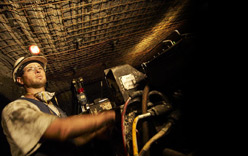
- introduction
- basic mining
process/terminology- form of deposit or seam
- the mining process
- associated functions
- different types of coal
- gas content and type
- exploration
- mine planning
- access to seam from surface
- development
- pillar extraction using
continuous miners
- longwall mining
- overview
- advancing and retreating longwalls
- equipment
- cutting processes
- ventilation/gas control
- stress/strata control
- installation/relocation
- common operational problems
- punch longwall mining
- shortwall mining
- alternative shortwall mining method - gretley colliery
- longwall top coal caving
- ventilation
- main fans
- main airways
- secondary or panel airways
- development face ventilation
- longwall ventilation
- ventilation planning
- ventilation equipment suppliers
- ventilation consultants
- gas control
- gas drainage/outbursts
- spontaneous combustion
- coal haulage
- personnel & material transport
- general
- personnel transport
- materials transport
- transport equipment suppliers
- specialised vehicles
- roadway maintenance
- subsidence
- gas utilisation
- strata control
- general
- mine design relating to dimensions and shape
- mine design relating to mining direction
- sacrificial support external to strata
- reusable supports external to strata
- strata reinforcement
- retention of failed strata
- strata support equipment suppliers
- mine services
- electric power
- water
- compressed air
- waste water
- communications
- communication equipment suppliers
- monitoring and remote control

FUNDAMENTALS